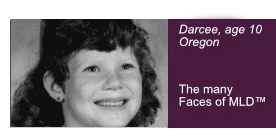MLD is caused by a genetic defect that results in the lack of a lysosomal enzyme, Arylsulfatase A. This enzyme normally breaks down substances called sulfatides. The missing enzyme causes sulfatides to increase in brain, peripheral nerves, liver, and kidney*. The accumulations are usually most obvious in the white matter of the central nervous system (CNS) and the peripheral nerves (PNS). Sulfatides cause the breakdown of the membranes myelin sheath, the "insulator" around the body's nerves, resulting in permanent damage to the nerves*.
There is a more rare form of MLD where the enzyme level is normal and the sulfatides are still high - meaning that they are not being broken down. This is called Saposin B Deficiency. The enzyme that is present is not "enabled" to a normal level of efficiency and can't break down the sulfatides which results in all of the same MLD symptoms and progression.
A disease that presents very similar to MLD with a frequency of about 1 in 1 million births is MSD, Multiple Sulfatase Deficiency. MSD is caused by a deficiency in multiple sulfatase enzymes including arylsulfatase A, arylsulfatase B, arylsulfatase C, iduronate sulfatase (deficient in Hunter syndrome), and heparan-N-sulfamidase, and/or (like Saposin B) the SUMF1 gene which provides instructions for making an enzyme called formylglycine-generating enzyme (FGE) to break down these proteins.
MLD is an autosomal recessive genetic defect. There are over 10,000 autosomal recessive disorders!*
Autosomal means that both males and females carry the defect.
Recessive means that if only one of the genes in the pair is defective then you are a carrier and not affected by the defect. This is the case with most parents - they come into a relationship as carriers, unaffected by MLD but carriers nevertheless, and they are as surprised as their spouse when they have a child with MLD.
Frequency - The carrier and birth rates are estimated. Some populations have a higher birth rate because of closed societies and consanguinity, most notably the Habbanite Jews, Navajo, and Yupik Eskimo.
-
Carriers ... 1 in 100 people are carriers on average
-
Chance of Carriers becoming a couple ... 1 in 10,000
-
Chance of a child of two carriers being affected ... 1 in 4
-
Birth Rate ... 1 in 40,000
Statistics - If two carriers have children then the statistical probabilities of the children being healthy, carriers or affected by MLD are as follows (see a picture here):
-
healthy - 25% ... 1 in 4
-
carrier - 50% ... 2 in 4 (carriers are not affected and live a MLD-free life)
-
affected - 25% ... 1 in 4
The chances of two carriers having a MLD affected child are 25% for each birth. The statistics reset for each child so it is possible to have a family that does not follow these ratios - it's a new "roll of the dice" for each child.
Extended Family - we are often asked about aunts/uncles and cousins. Here is a brief summary of the statistics of being a _carrier_ through common family members:
Parent of affected individual: assumed to be 100% (called an obligate carrier)
Unaffected sibling of affected individual ... 2 in 3 (~66.6%)
Aunt or uncle of affected individual ... 1 in 2 (50%)
First cousin of affected individual ... 1 in 4 (25%)
If you know you are a carrier, please remember that the frequency of other carriers in the general population is 1 in 100, so the chances of your child having MLD is 1 in 100 (odds your mate will be a carrier) times 1 in 4 (odds of two carriers have an affected child) = 1 in 400.
*More details about the permutations of the genetic statistics can be found here, including information about what happens when there is only one carrier or if one parent is affected by MLD.
Epidemiology ... There are an estimated 3,600 MLD births per year, with and estimated 1,900 alive in the US, 3,100 alive in Europe, and 49,000 alive worldwide. MLD Foundation has an extensive model of MLD births, survival, and deaths by global region that is available by request.
MLD Pseudo deficiency ... To further complicate the lab work, about 1 in 7 people have one copy of the so-called pseudodeficiency (Pd) allele which shows up in the lab work as a low ARSA level even though they are not affected by MLD. About 1 in 200 people will have low ARSA activity because they inherited two copies of the Pd allele, but they also do not have MLD. About 1% of the Pd alleles also have a disease-causing mutation on that copy of the gene. The confirming urinary sulfatide test eliminates Pd as the cause of a low ARSA reading.
The high frequency of of psuedo-deficiency is a challenge for the traditional screening methods used for Newborn Screening (NBS) of lysosomal diseases. Scientists are working on methods that are not susceptible to an out of limits reading from psuedo deficiency. As of early 2013 MLD Foundation is engaged with and supporting the sample testing of some work at the University of Washington along these lines.
Genes ... Each cell has 46 chromosomes (2 pairs of 23) that carry DNA strands. Genes reside on the DNA strands. There are 30,000 genes that make up the human genome. Click here to take a visual tour. The gene defect that causes MLD is located on chromosome #22 at position q13.31.
Chemistry ... Gene #22q13.31 controls the body's generation of an enzyme called arylsulfatase A, sometimes referred to as "ARSA". This enzyme is necessary to break down a by-product of normal cell life called sulfatide. If the enzyme is not present or activated then there is a buildup of sulfatides that, among other things, causes damage to the myelin sheath.
Mutations ... There are many different mutations (errors) that can occur on this gene. Dr. Rupar and the team at Bethany's Hope Leukodystrophy Research Laboratory in London, Ontario, Canada have organized over 130 different mutations into a searchable database here.
Neurology ... The myelin sheath is the insulator around the nerves which carry the signals from the brain to the various parts of the body. When the myelin sheath is damaged the brain cannot communicate with the body ... to the muscles, from the eyes, from other parts of the brain, to the mouth, etc.
As a genetic condition, MLD is not contagious - it cannot be passed to other schoolmates or friends by any sort of contact, fluid exchange, etc.. It is only passed on through the birth of a child. It can often be important to share this with teachers and schoolmates of the affected child or youth as they will need all of the support and sense of normalcy that they can get in the early stages of the progression of MLD.



 Tweet this page
Tweet this page

